Dalia Savy
AP Calculus AB/BC ♾️
279 resourcesSee Units
Answers and Review for Multiple Choice Practice on Parametric Equations, Polar Coordinates & Vector-Valued Functions
Parametric graph created in Desmos.
⛔STOP!⛔ Before you look at the answers make sure you gave this practice quiz a try so you can assess your understanding of the concepts covered in unit 9. Click here for the practice questions: AP Calculus Unit 9 Multiple Choice Questions.
Facts about the test: Both the AP Calculus AB and BC exams have 45 multiple-choice questions and you will be given 1 hour and 45 minutes to complete the section. This means it should take you about 35 minutes to complete 15 questions.
*The following questions were not written by CollegeBoard and although they cover information outlined in the AP Calculus AB/BC Course and Exam Description, the formatting on the exam may be different.
1. Which of the following is the derivative formula for differentiating a parametric equation?
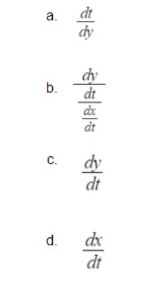
Answer: The answer is B. The derivative formula for a parametric equation is when you differentiate y and x separately in terms of t.
📄 Study AP Calculus, Unit 9.1: Defining and Differentiating Parametric Equations
2. Given x = 2√t and y = 3t^2 -2t. Find dy/dx. Evaluate at t=1.
A. -4
B. -2
C. 4
D. 0
Answer: Take the derivative of each function separately. Then plugin 1.
📄 Study AP Calculus, Unit 9.1: Defining and Differentiating Parametric Equations
3. What is the second derivative formula for a parametric equation?
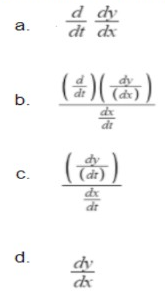
Answer: The answer is B. The numerator is the second derivative of the first derivative and the denominator is the first derivative of the x function.
📄 Study AP Calculus, Unit 9.2: Second Derivatives of Parametric Equations
4. Find all the points of horizontal and vertical tangency given x = t^2 + t and y = t^3 - 3t + 5.
A. t = -1 and -1/2
B. t = 1 and -1/2
C. t = 1 and -1
D. t = 1, -1, and -1/2
Answer: Take the first derivative. Set the numerator equal to zero for the horizontal tangent. Set the denominator equal to zero for the vertical tangent.
📄 Study AP Calculus, Unit 9.1: Defining and Differentiating Parametric Equations
5. What is the arc length formula for a parametric equation?
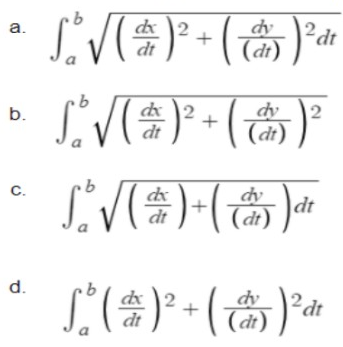
Answer: The answer is A. You must remember to square each of the functions and take the square root.
📄 Study AP Calculus, Unit 9.3: Finding Arc Lengths of Curves Given by Parametric Equations
6. What is the distance traveled by the object from t=1 to t=7 if the functions are dx/dt = tsin(t) and dy/dt=cos(t^2)
A. 15
B. 14.802
C. 13.015
D. 16
Answer: Plug into a graphing calculator!
📄 Study AP Calculus, Unit 9.3: Finding Arc Lengths of Curves Given by Parametric Equations
7. To find the speed of the particle, you take the absolute value of the…
A. position vector.
B. velocity vector.
C. acceleration vector.
D. displacement vector.
Answer: This should be the absolute value of the velocity vector. The speed can also sometimes be referred to also as the magnitude vector.
📄 Study AP Calculus, Unit 9.6: Solving Motion Problems Using Parametric and Vector-Valued Functions
8. When converting between polar and rectangular coordinates, you can use the following formulas to help you find x and y:
A. x = rcosθ and y = rsinθ
B. y = rcosθ and x = rsinθ
C. y=cosθ and x = sinθ
D. x = cosθ and y = sinθ
Answer: The equation will be A due to the connection to the unit circle of cosine being x and sine being represented by y.
📄 Study AP Calculus, Unit 9.7: Defining Polar Coordinates and Differentiating in Polar Form
9. The formula to find the derivative of a polar function is:
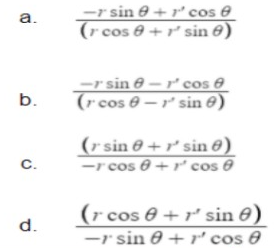
Answer: The answer is D since you are using the product rule of x=rcostheta and y=rsintheta.
📄 Study AP Calculus, Unit 9.7: Defining Polar Coordinates and Differentiating in Polar Form
10. What is the area formula for one polar curve?
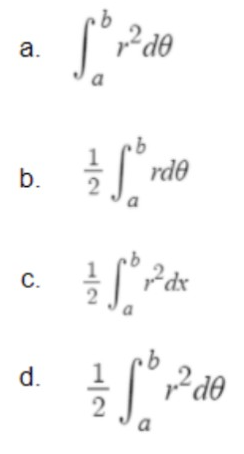
Answer: The answer is D as you need to square the radius and the function is in terms of theta.
📄 Study AP Calculus, Unit 9.8: Find the Area of a Polar Region or the Area Bounded by a Single Polar Curve
11. Find the area bounded by the graph of r = 3 + 3sinθ.
A. 42
B. 42.412
C. 21
D. 21.206
Answer: Remember to half the integral!
📄 Study AP Calculus, Unit 9.8: Find the Area of a Polar Region or the Area Bounded by a Single Polar Curve
12. What is the formula for the polar area between two curves?
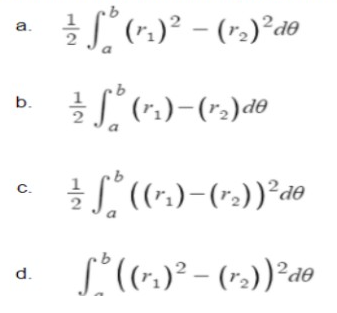
Answer: The answer is A. Remember to square each function when taking the integral.
📄 Study AP Calculus, Unit 9.9: Finding the Area of the Region Bounded by Two Polar Curves
13. Find the area inside the smaller loop of the limacon r = 2cosθ + 1.
A. 1
B. 0.6
C. 0.544
D. 0.78
Answer: Find the points of intersection first which will be 4pi/3 and 2pi/3 then take the integral of this.
📄 Study AP Calculus, Unit 9.9: Finding the Area of the Region Bounded by Two Polar Curves
14. Determine the area that is inside r = 3 + 2sinθ and outside r = 2.
A. 23
B. 24
C. 24.187
D. 25
Answer: Set the two functions equal to find the points of intersection. From there then find the integral.
📄 Study AP Calculus, Unit 9.9: Finding the Area of the Region Bounded by Two Polar Curves
15. What is the arc length formula of a polar curve?
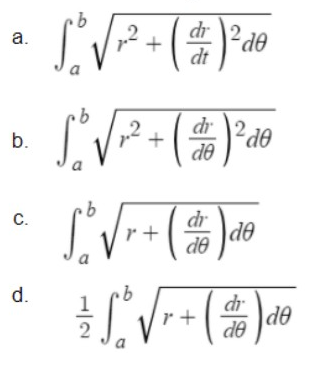
Answer: The answer is B. Both the derivative and the radius must be squared. You are differentiating in terms of theta.
📄 Study AP Calculus, Unit 9.3: Finding Arc Lengths of Curves Given by Parametric Equations
What can we help you do now?
🔍Study for Unit 10
🦘Jump to AP Calculus Unit 10 Multiple Choice Questions
🤝Connect with other students studying AP Calculus with Hours
Browse Study Guides By Unit
👑Unit 1 – Limits & Continuity
🤓Unit 2 – Fundamentals of Differentiation
🤙🏽Unit 3 – Composite, Implicit, & Inverse Functions
👀Unit 4 – Contextual Applications of Differentiation
✨Unit 5 – Analytical Applications of Differentiation
🔥Unit 6 – Integration & Accumulation of Change
💎Unit 7 – Differential Equations
🐶Unit 8 – Applications of Integration
🦖Unit 9 – Parametric Equations, Polar Coordinates, & Vector-Valued Functions (BC Only)
♾Unit 10 – Infinite Sequences & Series (BC Only)
🧐Multiple Choice Questions (MCQ)
✍️Free Response Questions (FRQ)
📆Big Reviews: Finals & Exam Prep

Fiveable
Resources
© 2023 Fiveable Inc. All rights reserved.